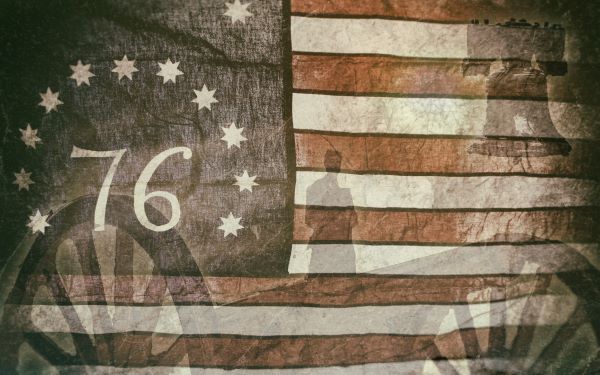John Paul Jones
By David Streater, Ph.D.
Burke County, NC
This article is an educational moment in American history about those who made a difference during the Revolutionary War era and how they served our country.
Ironically, a great American patriot was born in Kirkcudbrightshire, Scotland, on July 6, 1747, and educated at the Kirkbean Parish School. John Paul would explore all parts of the ships at the local Port of Carsethorn. He and his friends would talk to the sailors about their adventures and imagine being at sea with them. Paul would bark out orders to his friends, pretending to be the ship’s captain in battles.
At 12, John started his naval career as a cabin boy working for the Younger Shipping Company. His first voyage was on the Friendship, which allowed him to see his older brother in Virginia. Younger Shipping soon went bankrupt, and John worked aboard slave and cargo ships. By 19, Paul earned the first-mate rank from the knowledge and experiences he acquired.
In parts of the United Kingdom, Paul was known as a kidnapper and a pirate. In 1773, John Paul found himself in a problematic situation: while sailing in the West Indies, he killed a mutinous sailor. Even though John claimed self-defense, he knew that he would not be believed in an English court.
Disgusted with slavery and his current predicament, he hurried to America. John Paul added Jones to his last name, as an alias, to conceal his identity. John’s seamanship and his new identity put him in a position to become a Revolutionary War hero and a gallant naval officer.
Arriving in Philadelphia, Jones joined the Navy and was commissioned as a first lieutenant on December 7, 1775. Mentored by Commodore Esek Hopkins, the first commander of the American Navy, Jones received his own ships and gained victories over and possessions from British frigates. In June 1776, Congress appointed Jones as the captain of the Ranger and introduced him to Benjamin Franklin. During the next two years, John captured and destroyed British vessels. These encounters earned him the command of the French-built ship, Duc de Dures, which he renamed Bonhomme Richard to honor Benjamin Franklin.
On September 23, 1779, John Paul Jones led history’s most famous naval battle. Aboard the Bonhomme Richard in the British Isles, Jones and a small flotilla blocked a British convey. During a several-hour barrage with the British ships Serapis and the Countness of Scarborough, the Bonhomme Richard started sinking. With the Bonhomme Richard burning, British Captain Richard Pearson commanded Jones to surrender. Jones replied, “Surrender!? I have just begun to fight!”. At battle’s end, Jones and his crews captured the British ships. The American flag was transferred to and hoisted on the Serapis with John Paul Jones in command, as the Bonhomme Richard sank. With the event at Yorktown and the Battle of Chesapeake bringing the Revolutionary War to an end, the Continental Navy was dissolved.
As an admiral, Jones served Empress Catherine the Great in the Russian Navy for a year after the war. His leadership and experiences had a significant role in capturing the Ottoman (Turkish) fortress at Ochakov and in the Black Sea campaign. After these battles, Jones then relocated to Paris in 1789.
“In June 1792, Jones was appointed U.S. Consul to treat with the Dey of Algiers.” However, at age 45, on July 18, 1792, he died from a brain tumor and kidney problems before he could begin his diplomatic duties. All, including his adversaries, remembered Admiral Jones. He was buried in an untended cemetery for foreign-born Protestants in Paris and forgotten.
In 1905, Jones’ body was relocated to the United States Naval Academy and laid in an ornate sarcophagus. Despite his troubled times in the U.K. and Russia, John Paul Jones was honored during his life with many accolades and awards, including the title of the Father of the United States Navy.
Please visit your Charters of Freedom setting in most western North Carolina counties. A Charters of Freedom setting consists of the Declaration of Independence, the United States Constitution, and the Bill of Rights. They are on permanent display analogous to the Charters of Freedom in the National Archives, Washington, DC. Please visit FoundationForward.com to learn more about our existing settings. Vance and Mary Jo Patterson are the benefactors and originators of Foundation Forward, a 501(c)(3) education non-profit.
Teachers are encouraged to contact Dr. Streater for information and complementary student education materials to enhance experiential field trips to Charters of Freedom settings. In addition, everyone is welcome and urged to obtain a personalized engraved legacy paver for placement at their local Charters of Freedom setting. Please contact Dr. Streater (david.streater@mymail.barry.edu) for engraved legacy paver information and complementary educational materials.
_______________________________________
Dr. David Streater is the director of education for Foundation Forward. He is a retired college instructor and administrator, and a retired probation and parole officer/administrator. David is a criminologist who has an acute history interest, served in the Navy, and is a resident of Burke County, NC.
You can read more Good Christian News HERE.
Read more about our founding fathers HERE.
_______________________________________







